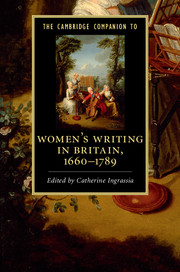Book contents
- The Cambridge Companion to Women’s Writing in Britain, 1660–1789
- The Cambridge Companion to Women’s Writing in Britain, 1660–1789
- Copyright page
- Contents
- Notes on contributors
- Chronology
- Introduction
- Part I Women in print culture
- Part II Genres, modes, and forms
- Guide to further reading
- Index
- Cambridge Companions to …
- References
Guide to further reading
Published online by Cambridge University Press: 05 May 2015
- The Cambridge Companion to Women’s Writing in Britain, 1660–1789
- The Cambridge Companion to Women’s Writing in Britain, 1660–1789
- Copyright page
- Contents
- Notes on contributors
- Chronology
- Introduction
- Part I Women in print culture
- Part II Genres, modes, and forms
- Guide to further reading
- Index
- Cambridge Companions to …
- References
- Type
- Chapter
- Information
- The Cambridge Companion to Women's Writing in Britain, 1660–1789 , pp. 242 - 253Publisher: Cambridge University PressPrint publication year: 2015



